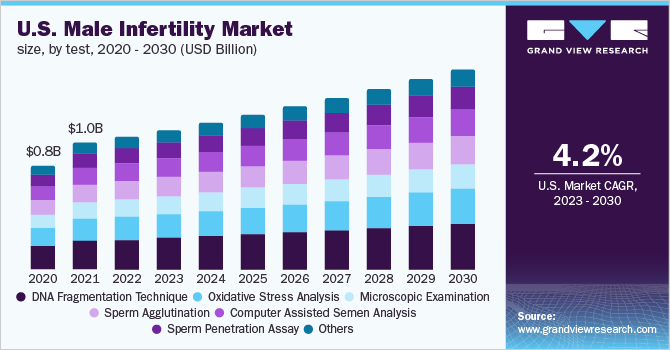Male Infertility Industry Overview
The global male infertility market size was valued at USD 4.0 billion in 2022 and is expected to expand at a compound annual growth rate (CAGR) of 4.9% from 2023 to 2030. Increasing infertility rates across the globe and the adoption of assisted reproductive technologies (ARTs) are expected to drive the market for male infertility in the forthcoming years. ARTs cover a wide spectrum of infertility treatments and offer solutions for males facing problems, such as low sperm count, abnormal sperm quality, and poor motility. Moreover, ARTs offer a high success rate as compared to medications. The market for male infertility is expected to witness significant growth in the future owing to technological advancements in the field of assisted reproductive technologies.

With the general acceptability and diagnostic techniques' ability to give an accurate analysis of sperm DNA integrity, DNA fragmentation technology is projected to grow steadily in the future. DNA fragmentation in sperm is one of the main reasons for male infertility. For diagnostic reasons, this technique is performed to diagnose male infertility. COVID-19 affected healthcare services severely. Only emergency medical procedures were allowed during the initial phase of the pandemic. The diagnostics, personal protection equipment, and critical medical supplies have seen increasing demand, while medical procedures have dropped by 50% to 60%, depending on the market.
Gather more insights about the market drivers, restraints, and growth of the Global Male Infertility market
The clinical disease generated by the SARS-CoV-2 virus, COVID-19, has been linked to a huge cytokine storm and organ system destruction. Despite the lack of evidence for SARS-CoV-2 virus detection in the testis, testicular injury and dysregulation of gonadotropins linked to inflammation have been documented in some studies. Furthermore, as a result of the pandemic's fast evolution, constantly updated medical therapies and governmental regulations that cause delays in care might affect fertility.
An increase in the global prevalence of infertility is a significant clinical problem. Around 48 million couples suffer from infertility worldwide. Of all cases, about 20% to 30% of cases are due to male factor infertility. This may be due to one or a combination of factors, such as abnormal morphology, lower sperm concentration, and poor sperm motility. Hence, increasing male infertility and growing awareness regarding the same have further prompted the use of drugs, hormonal therapy, and ART. Alcohol intake, smoking, obesity, stress, and lifestyle changes are some of the major factors that can be attributed to infertility in males. According to the National Center for Health Statistics, the fertility rate in males below 30 years has decreased globally by 15% from 2006 to 2010.
Continuous efforts in R&D are carried out for a better understanding of the idiopathic world of infertility. Hence, companies are investing in the development of devices for identifying the root cause and targeted treatment. Furthermore, the development and commercialization of hormonal therapy are likely to drive the market for male infertility during the forecast period. Governments of various countries have taken initiatives to improve the reimbursement scenario for infertility-related treatments. In addition, improved safety of patient data due to standardization of regulations is expected to increase patient preference for infertility treatments.
Browse through Grand View Research's Healthcare Industry Research Reports.
In Vitro Fertilization Market - The global in vitro fertilization market size was valued at USD 23.6 billion in 2022 and is expected to expand at a compound annual growth rate (CAGR) of 5.72% from 2023 to 2030.
Uterine Manipulation Devices Market - The global uterine manipulation devices market size was valued at USD 245.76 million in 2020 and is expected to expand at a compound annual growth rate (CAGR) of 5.6% from 2021 to 2028.
Male Infertility Market Segmentation
Grand View Research has segmented the global male infertility market based on test, treatment, and region:
Male Infertility Test Outlook (Revenue, USD Million, 2017 - 2030)
- DNA Fragmentation Technique
- Oxidative Stress Analysis
- Microscopic Examination
- Sperm Agglutination
- Computer Assisted Semen Analysis
- Sperm Penetration Assay
- Others
Male Infertility Treatment Outlook (Revenue, USD Million, 2017 - 2030)
- Assisted Reproductive Technology and Varicocele Surgery
- Medication
Male Infertility Regional Outlook (Revenue, USD Million, 2017 - 2030)
- North America
- Europe
- Asia Pacific
- Latin America
- Middle East & Africa
Market Share Insights
May 2019: The National Good Laboratory Practice (GLP) Compliance Monitoring Authority (NGCMA), Govt. of India, granted the Good Laboratory Practices Certification to Cadila Pharmaceuticals for its Dholka facility. The certification makes the company a GLP compliant facility and will provide recognition to its research work in all OECD member countries.
November 2017: Aytu BioScience received approval from the Australian Therapeutic Goods Administration (TGA) for the MiOXSYS system as an aid in the assessment of semen quality.
Key Companies profiled:
Some prominent players in the global male infertility market include:
- Bayer Healthcare
- Andrology Solutions
- Aytu BioScience, Inc.
- Cadila Healthcare Ltd.
- Halotech DNA SL
- EMD Sereno, Inc.
- SCSA Diagnostics, Inc.
- Intas Pharmaceuticals Ltd.
Order a free sample PDF of the Male Infertility Market Intelligence Study, published by Grand View Research.


No comments:
Post a Comment